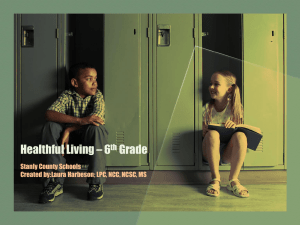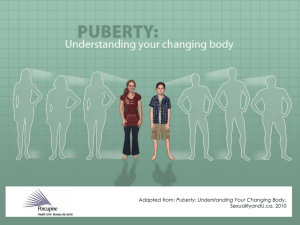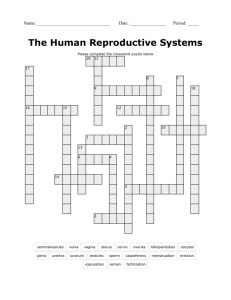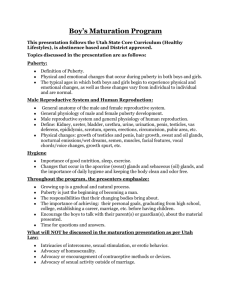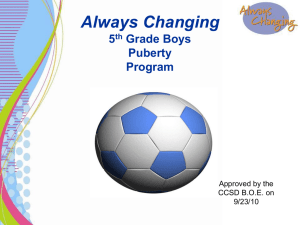Growth & Development: Grade 6
advertisement
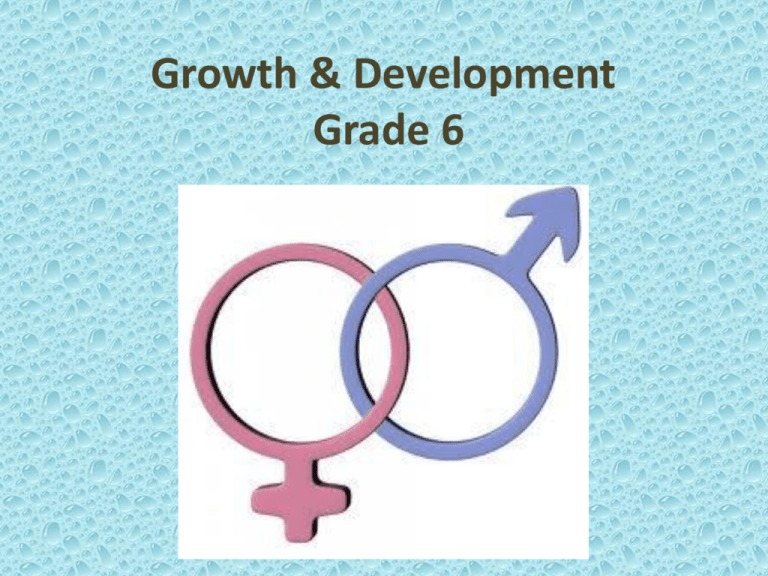
Growth & Development Grade 6 Grade 6 Expectations *Identify the major parts of the reproductive system and their functions and relate them to puberty. *Relate the changes at puberty to the reproductive organs and their functions. *Apply a problem-solving/decision making process to address issues related to friends, peers and family relationships The 10 Rules 1. 2. 3. 4. 5. 6. 7. Relax. It will be okay. We are talking about the facts. Please ask questions. Make them mature. Use the proper names and not slang. It’s okay to giggle (especially if I make a joke)! It’s NEVER okay to laugh at a classmate’s question or idea. It’s NEVER okay to make a rude comment or make someone feel uncomfortable. 8. Please … no ‘yucks’ or ‘eews’. 9. Don’t use names. No personal stories or questions. 10. Keep it in health class. Unless of course you want to bring it up at the dinner table with your parents :). Remember!....... • • When it comes to learning and talking about growth and development, everyone in this room has: • • • • • • Different knowledge and backgrounds. Different beliefs (cultural, family). Different comfort levels. Things they know. Things they ‘think’ they know. Questions. THIS IS ALL OKAY! Looking at Myself Directions: Complete each statement as it applies to yourself. • The thing I look forward to most about growing up is: • The thing I am most concerned about growing up is: • The thing I like best about myself is: • The thing about myself I would most like to improve: Male…Female or both? • • • • • • • • • • • • • • • • • • • • • • Directions: Read each word below and place an F if it relates to a female, an M if it relates to a male, and a B if it relates to both male and female. 1. _________ testosterone 21. _________ semen 2. _________ labia 22. _________ erection 3. _________ sperm 23. _________ urethra 4. _________ vulva 24. _________ perspiration (sweat) 5. _________ pubic hair 25. _________ pimples 6. _________ puberty 26. _________ foreskin 7. _________ ejaculation 27. _________ eggs 8. _________ hormones 28. _________ penis 9. _________ ovaries 29. _________ prostate gland 10. _________ cervix 30. _________ clitoris 11. _________ menstruation 31. _________ seminal vesicles 12. _________ testicles 32. _________ rounder hips 13. _________ vagina 33. _________ body growth 14. _________ bladder 34. _________ epididymis 15. _________ uterus 35. _________ new feelings 16. _________ fallopian tubes 36. _________ nipples 17. _________ wet dreams 37. _________ mood swings 18. _________ estrogen 38. _________ sexual thoughts and feelings 19. _________ scrotum 39. _________ feels self-conscious 20. _________ deeper voice 40. _________ vaginal secretions In order to make a baby one ________ cell from a female and one ________ cell from a male is needed. At puberty our bodies begin changing so that we are able to make a baby. • • • • • • • • • • • • • • • • • • • • Male…Female or both? 1. ____M___ testosterone 2. ____F____ labia 3. ____M___ sperm 4. ____F____ vulva 5. ____B____ pubic hair 6. ____B____ puberty 7. ____M___ ejaculation 8. ____B____ hormones 9. ____F____ ovaries 10. ____F____ cervix 11. ____F____ menstruation 12. ____M___ testicles 13. ____F____ vagina 14. ____B____ bladder 15. ____F____ uterus 16. ____F____ fallopian tubes 17. ____M___ wet dreams 18. ____F____ estrogen 19. ____M___ scrotum 20. ____M___ deeper voice 21. ____M___ semen 22. ____M___ erection 23. ____B____ urethra 24. ____B____ perspiration (sweat) 25. ____B____ pimples 26. ____M___ foreskin 27. ____F____ eggs 28. ____M___ penis 29. ____M___ prostate gland 30. ____F____ clitoris 31. ____M___ seminal vesicles 32. ____F____ rounder hips 33. ____B____ body growth 34. ____M___ epididymis 35. ____B____ new feelings 36. ____B____ nipples 37. ____B____ mood swings 38. ____B____ sexual thoughts and feelings 39. ____B____ feels self-conscious 40. ____F____ vaginal secretions In order to make a baby one _egg_ cell from a female and one _sperm_ cell from a male is needed. At puberty our bodies begin changing so that we are able to make a baby. Puberty Scramble • • • • • • • • • • • • • • • 1. Boys’ voices 2. Breast development 3. Erections 4. Deodorant use 5. Testosterone and Estrogen 6. Boys before puberty 7. Ejaculation at night 8. Pimples 9. Strong sexual feelings 10. Boys 11. Girls 12. Menstruation 13. Moodiness 14. Feeling self-conscious 15. Calling someone sexual names become deeper is often the first sign of puberty for girls can happen for NO REASON prevents body odour are hormones that cause changes have NO sperm is called a wet dream oil ducts are blocked with bacteria cause you to be attracted to looks usually start puberty later than girls are usually first to want to date is a sign you can become a mother is caused by hormones is due to body changes is sexual harassment All About Boy’s Hormones Cause Changes In The Male FSH travels through the bloodstream and targets the testicles. FSH stimulates the testicles which causes the testicles to produce sperm. With sperm production the male hormone testosterone is produced which causes the changes in the male. Boys at Puberty Label the diagram using the suggestions at the bottom of the worksheet. “Testosterone” brings about changes: • • • • • • • • • • voice-changes Develop relationships pimples develop Voice changes developing new relationships underarm hair Underarm hair pubic hair sweat more Pubic Hair facial hair production of sperm wet dreams new thoughts and feelings New thoughts & feelings Facial Hair & Pimples Sweat More Wet Dreams Sperm Production The Changes The Male Experiences At Puberty • • • • • • New feelings Muscles & Tissue building Deepening of voice Development of sex organs Growth of body hair Masculine body features New feelings Deepening of the voice Muscles & Tissue building Masculine body features Develop sex organs Growth of body hair All About Girl’s Puberty Changes Hormones Cause Changes In The Female Pituitary Gland FSH travels through the bloodstream and targets the ovaries. FSH stimulates the egg cells to mature which causes the cells to produce estrogen. Estrogen will cause the changes in the female. Girls at Puberty “Estrogen” brings about these changes: • leg hair • developing new relationships • underarm hair • sweat more • pubic hair • new thoughts and feelings • hips widen • breasts develop • pimples develop • menstruation • eggs mature New thoughts and feelings Develop new relationships Pimples Develop Breasts develop Underarm hair Hips widen Eggs mature Pubic Hair Menstruation Leg Hair Sweat more Everything You Wanted to Know About Puberty For Girls • • • • • • New feelings Menstruation Ovulation Breast development Feminine features Body hair New feelings Breast development Feminine features Body hair Menstruation Ovulation Male Reproductive System Directions: Using the word below, label the parts. • Bladder • penis Seminal Vesicle • urethra Bladder • testicle Prostate Gland • epididymis • Scrotum Urethra • prostate gland • seminal vesicle Epididymis Penis Testicle Scrotum Male Reproductive Parts • Scrotum – The sac of skin which holds the pair of testes. • Penis – It is a spongy, muscular organ that becomes enlarged and erect when sexually aroused. It varies in size. • Urethra – The tube through which urine and semen leave the body. • Testicles – The male sex glands which produce sperm (testes) and testosterone (a male hormone). • Epididymis – A tube on the surface of each testicle which stores and transports sperm to the vas deferens. • Vas deferens– A sperm duct which leads from each testicle to the ejaculatory duct. • Seminal vesicles– Pair of glands which add a nourishing fluid to the sperm. • Prostate – Produces a milky fluid which forms part gland of the semen. • Bladder – A bag-shaped organ which holds the urine until it is discharged. • External Penis • • tube-like organ of spongy tissue (no bone) • • grows (average size between 2-4"; size not important; • erect size average 6-7") • • number of erections increase • • reproduction function • • organ through which urine and semen leave the body Scrotum • •grows to adult size • • darkens in colour • • grows hair • • helps maintain sperm at correct temperature (lower than • body temperature) because it is outside the body • • protective covering/sac for testes Testicles • • grow to adult size (walnut size) • • one may be smaller and/or hang lower than the other • • begins to produce the hormone testosterone • • produces sperm continuously • • produces the hormone testosterone • Internal Sperm • • starts to be produced in testicles at puberty and • continues throughout lifetime • • if united with egg, makes a baby Urethra • • tube in penis from bladder • • tube in penis that carries urine and • semen out of the body • • when semen is released, valve blocks off branch to • bladder and vice versa Prostate gland • • produces a fluid at puberty that mixes with sperm Seminal vesicles • • two glands begin to produce fluid at puberty • • makes seminal fluid Vas deferens • • tube from testicles that joins with seminal vesicles • • produces seminal fluid • • part of the path that carries sperm Care of male reproductive organs • • daily cleansing with soap and water (bath or shower) • • for an uncircumcised* male, foreskin must be pulled back in order to be cleansed properly • • protective gear (jock strap) is necessary during contact sports because most of the male Circumcision • the surgical removal of foreskin at the head of the penis • usually for religious or cultural reasons • rarely for medical reasons • Does not affect function. Female Reproductive System Diagram Directions: Using the words below, label the parts. • cervix • uterus • Ovary • vagina • egg cell • uterine lining • fallopian tube Fallopian Tube Fallopian Tube Egg Cell Ovary Uterine Lining Uterus Cervix Vagina The Female Anatomy Reproductive System • Vagina Opening – The opening to the vagina. • Vagina – A muscular tube which expands to fit the penis during intercourse or a baby during birth. • Cervix – The narrow inner end of the vagina, which leads to the uterus. • Uterus – Pear-shaped organ which nourishes and holds a developing fetus. It prepares for a pregnancy each month by forming a blood and tissue lining. • Ovary – It releases egg cells and produces hormones (estrogen and progesterone). • Fallopian tubes– Tubes leading from the ovary to the top of the uterus, with finger-like projections that surround an ovary. • Uterine Lining – The lining of the uterus which thickens and lining sheds during the menstrual cycle. • Clitoris – a highly sensitive organ above the urinary opening which may provide pleasure in orgasm to females when stimulated. • Pubis – A fleshy pad of tissue which is covered with pubic hair. • Labia – Fold of skin (inner and outer) which protect the (inner, outer) internal reproduction organs. EXTERNAL Labia (inner, outer) • • increased oil/sweat production • • gets thicker, more wrinkly, darker in colour • • protection of internal reproductive organs Mons pubis • • thickens to form more padding • • hair grows on it • • protects/cushions the pubic bone Clitoris • • grows to adult size (approximately the size of pencil head eraser) • • more sensitive • • sensitive to touch because of many nerve endings Urinary opening (urethra) • grows to adult size • urine leaves the body through this opening Vaginal opening • • grows to adult size • • able to stretch • • menstrual flow leaves the body • • reproductive function • • baby exits from this opening INTERNAL Vagina • • normal discharge from vagina-odourless, cloudy, white (cleansing mucous) • • starts up to two years before menstruation • • avoid perfumed bath, deodorant sanitary products and douching • • white, cotton underwear preferable to prevent yeast • • leads to other internal reproductive organs • • used for reproduction and birth of baby • • menstrual flow exit Uterus • • grows to about the size of a fist • • changes position to tilt in pelvic cavity • • where a baby grows • • very stretchy • • lining is shed during menstruation Fallopian tubes • • on either side of uterus • • passageway from uterus to ovary, helps move egg along • • fertilization takes place here Ovaries • • grows to adult sizes (size of a walnut) • • starts producing the hormones estrogen and Progesterone • • stores ova (hundreds of thousands) • • releases ovum about once a month starting at puberty • • produces hormones Endometrium • • lining of the uterus (thickens to prepare for implantation) • • thickens and sheds during menstrual cycle Menstrual Cycle Menstrual Cycle • • • • Normal menstrual cycle Bleeding ranges from 5-7 days. 28-35 days is a complete cycle. normal amount of bleeding requires about 2-4 pad changes a day. • outside these amounts is not necessarily abnormal. Menstrual Protection • Pads are the most popular menstrual protection products available on the market today. • They are made out of absorbing materials and placed on the underwear to absorb the menstruation. There are several brands available who manufacture these type of products. • They can be designed to suite different menstrual flows from regular to abundant. • They can be regular or with wings which stick to the sides of the underwear for better positioning. Menstrual Protection • Tampons are cylindrical menstrual protection products which can come under different lengths and widths to suite every woman’s needs. • These tampons need to be inserted into the vagina to absorb the blood. • A string is attached to the end of the tampon in order to allow you to pull the tampon out for changing. You can find tampons which come with an applicator to help the insertion or tampons which need to be inserted using your fingers. • They are great because they don't show and they allow certain activities like swimming during a period to be performed. Decision-Making Model: Scenarios Scenario 1 • Susie’s brother/sister is always coming into her bedroom without knocking. • She has just started wearing a bra and wants privacy when changing. • Her brother/sister never listens to her demands for privacy. What could • she do? Why does she feel this way? Scenario 2 • You are dancing at a school dance and your partner puts his/her hands on • your butt. You feel uncomfortable with this behaviour. Why do you feel • this way? What might you do? Scenario 3 • Connie told Jim that Michelle really likes him. Michelle has been talking • to Jim a lot lately and she wants to be in his work group. Jim is uncomfortable • because he’s not really interested in girls. How do you think that • he feels? What might he do? Scenario 4 • Michael likes Jenny, the new girl in class, and wants to ask her to dance. • Michael is shorter than Jenny and is very shy and does not know how to • ask her to dance. How does Michael feel and why? What might he do? Scenario 5 • A girl/boy in your class likes you and you like him/her, too. He/she pushes • and teases about how your body is changing whenever he/she sees you. • This makes you feel annoyed. How do you feel? What might you do? Ways to Express Affection • Tell the person you enjoy their company. • Smile at them. • Others?
